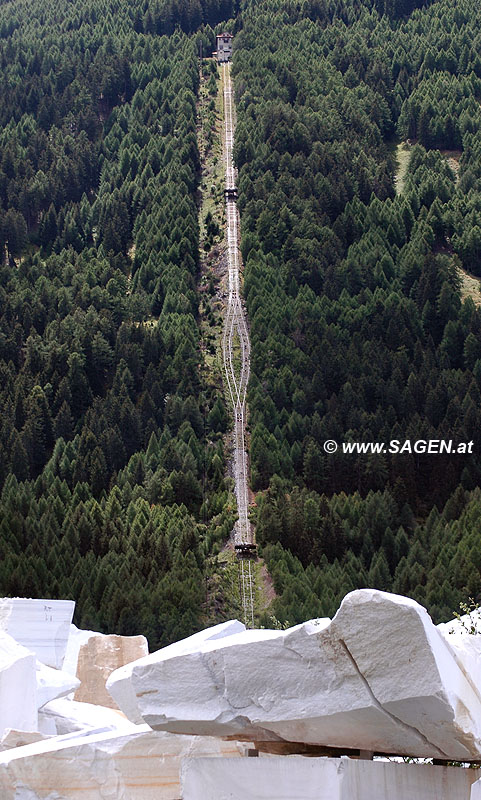Marble road in Laas – technological wonder of the world, Part 1
The marble road in Laas (Vinschgau, South Tyrol, Italy) can rightly be considered to be one of the technological wonders of the world. It is a unique construction and it is situated in the incomparable surroundings of the Stilfser Joch National Park.
The high-level of technical achievement in the construction of the marble road is proved by its having been in operation in an almost unchanged state since 1930. It is the last construction of its kind, preserved in its original state and still in operation, in Europe. But now the preservation of this unique construction is in danger.

Inclined cable railway for marble transportation in Laas
Construction by company "Adolf Bleichert and Co. AG", Leipzig, 1929, the biggest brake incline in Europe.
© Wolfgang Morscher, 3 August 2007
The marble road in Laas is a four-stage railway construction, which uses a brake incline for the transportation of marble from the Geflan Quarry (2200 m above sea level) and the Weisswasser Quarry (1555 m above sea level) to the valley below. Weisswasser (meaning “White Water”) got its name from a spring whose water is white because it is coloured by white marble. To descend to the valley the marble has to overcome a bb level difference of 1500 meters.
Geographical overview of marble road in Laas:
Note: for more comfortable navigation zoom in the image
On the map you may choose between options "map view" and "satellite imagery"
Originally marble blocks were loaded onto squared tree trunks and with the help of tail-ropes they were rolled down to the valley. On the flat ground trolleys and sleighs were used. In 1882 on mount Geflan a sloping roadway of round timbers was constructed. The marble blocks were placed on the roadway and rolled downhill. Thick hemp ropes attached to solid posts driven into the ground on both sides of the slope acted as a braking mechanism.
In 1928 the engineer Francini and the company “Bleichert and Co.” of Leipzig designed and built a transport construction of enhanced design. The construction of this system, which works almost automatically, was carried out in 1929 and 1930.
Marble blocks are delivered from the Geflan and Weisswasser quarries by way of the so called Marble road which travels through three tunnels to the aerial cableway station.
From here the marble blocks are lowered 170 meters on the western side of the Laas valley. Then they are put onto the wagons of a narrow-gauge railway and a locomotive tows them for 1900 meters to the upper station of the brake incline. There is no need for any further transshipment of the marble blocks because the wagons of the narrow-gauge railway can easily be pushed onto the platform of the cable railway.
A cargo weighing 40 tons and traveling at a speed of 1m/second can be lowered by the cableway in 16 minutes (the difference in altitudes = 480 meters). On the flat, wagons are driven to a store by a locomotive.
Marble from Laas is very strong and impermeable: that is why it is very popular with sculptors and producers all over the world. There are different types of marble: "snow-white Statuario", "Bianco Lasa Classico", "Bianco Lasa Ortles", "Bianco Lasa Cevedale", "Bianco Lasa Cevedale Nuvolato", "Vena Oro", "Vena Verde", "Arabescato", "Fior di Melo" and "Lasa Fantastico".
“The marble mining factory in Laas” was founded in 1865 by Johann Steinhaeuser. Josef Lechner, nicknamed “Marble Josef”, used Laas marble from Weisswasser and Jennwand to achieve international success. A school for marble processing was founded in Laas 1982.
(from the book “Excursion in Vinschgau” by Rudolf Gurschler, Schlanders 1994, pp.175-203)
Since the opening of the Marble road in Laas in 1930 there has never been an accident. Nor has the construction ever needed repair. The spare parts delivered in 1929 by the Bleichert company have never needed to be used.
All the marble quarries of Laas are situated in the Italian national park, Stilfser Joch. The brake incline – the first sloping elevator in the world – is the safest and most environmentally friendly method of transporting marble.
At present this unique industrial monument in the Alps is in danger.
© Wolfgang Morscher and Hubert Tscholl, February 2008